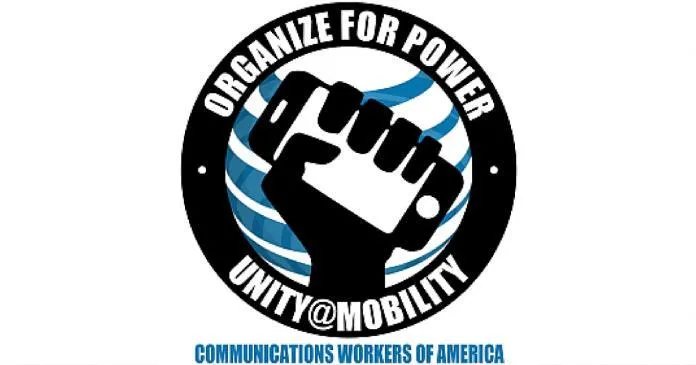Tentative Mobility Benefit Agreement Reached with AT&T Mobility

Washington, D.C. -- The Communications Workers of America AT&T Mobility National Benefits Bargaining committee has reached a new tentative agreement with AT&T Mobility covering 42,000 workers.
This proposed national agreement covers health care and other benefits.
CWA District 1 Vice President Dennis Trainor said CWA “accomplished our main goal, which was to put health care benefits bargaining back in the regional bargaining agreement process and to make health care affordable for all Mobility workers.” There are four separately negotiated Mobility contracts that now cover compensation and working conditions.
An earlier agreement was voted down by the members last month, and continued negotiations resulted in the tentative proposal that is being provided to the membership for a ratification vote.
Ratification will be conducted over the next several weeks.
Among the highlights of the new proposed agreement:
- Reduced premium costs for 20,000 employees hired after 2014.
- Employees with dependent children and no covered spouse will pay lower rates under a new 4-tier contribution structure.
- Employees in Puerto Rico will be able to take advantage of popular HMO plans with much lower contribution rates.
- A new “Option 2” plan will be introduced with lower premium costs.
Contact: Candice Johnson, CWA Communications, 202-434-1168, [email protected]
New 2016 Mobility Benefit Plan Is More Affordable for Many and paves the way for bargaining health care benefits in regional collective bargaining agreements
We had two main goals for our 2016 negotiations over the National Bargained Benefits Plan at AT&T Mobility – we wanted to make health care more affordable and we wanted to put health benefits into the regional collective bargaining agreements. We met these goals with this new tentative agreement.
- We heard from many members that contribution rates were too high and that some of us are opting out of the Mobility coverage, so we wanted to make sure there were affordable options. We addressed this concern in a number of ways:
- 20,000 employees who were hired after 2014 will no longer be required to pay a higher premium contribution than their more senior co-workers.
- Employees with dependent children and no covered spouse will pay lower rates under a new 4-tier contribution structure.
- Employees in Puerto Rico will be able to take advantage of popular HMO plans with much lower contribution rates, reflecting the lower cost of health care there.
- A new “Option 2” plan will be introduced that has much lower premiums than the traditional PPO plan, though it has higher out-of-pocket costs.
- As a result of renegotiating the agreement when the first tentative agreement was not ratified, we pushed the effective date of the spousal surcharge to 2019.
- We wanted to end the separation of a key part of our economic package – our benefits plans -- from our collective bargaining over wages and working conditions. In this tentative agreement we have negotiated an “unwind” agreement that will put health benefits back into the regional contracts when this NBBP agreement expires in 2020.
One Agreement in Four Parts
Four documents make up the new Agreement covering about 43,000 CWA-represented employees of Mobility.
1. National Bargained Benefit Plan for Employees of AT&T Mobility Services LLC Benefit Outline Summary.
This is the main document that spells out all the terms of the medical, prescription drug, dental and vision benefits that were negotiated. Some highlights include:
- The “new hire” date will be moved to January 1, 2017. All employees who were hired or transferred into Mobility after January 1, 2014, who currently are considered “new hires” for benefits purposes, will become “current employees” for benefits.
- Eligibility for the Company subsidy for the individual employee will begin in the month in which the employee has 90 days of service.
- New Option 2 coverage will be available with higher deductibles and out-of-pocket costs than the traditional PPO, but also with much lower monthly contributions.
- Four coverage tiers are now available in order to reduce monthly contributions for employees covering dependents on their own: Individual; Individual + Child(ren); Individual + Spouse; Family
- For members who live in Puerto Rico, new healthcare options will be available:
- Negotiated caps on the HMO costs
- Medical incentives available with new plans
- Lower costs to align with the healthcare market costs in Puerto Rico
- Tobacco Surcharge: A surcharge of $50 per month will be charged to smokers. Smokers will self-identify in open enrollment, and the surcharge will be waived if the employee enrolls in a smoking cessation program, the cost of which is covered.
- Spousal Surcharge: Effective in 2019, a surcharge of $100 per month will be charged unless the employee attests that his or her spouse/legally recognized partner does not have access to medical coverage; in which case it will be waived.
2. Letter to Patricia Telesco dated June 7, 2016 regarding Puerto Rico benefits.
This side letter details the provisions of the Puerto Rico capped HMO contribution rules and is part of the Agreement.
This is language for plan year 2020, when the tax on high cost health plans is currently scheduled to begin. The tax applies to employers, not employees. The agreement details the terms under which the union and company have agreed to hold talks to modify the health plan design to avoid the tax, if that should become necessary. In that event, employees will pay no more in total costs as a result of such plan design changes.
This is the document that “unwinds” the National Bargained Benefits Plan Agreement and puts the benefits back together with the Regional Agreements beginning with the next rounds of bargaining. The terms of this current NBBP agreement will remain in place through 2020, but each regional bargaining unit will incorporate those terms within their overall collective bargaining agreement, and will negotiate new terms to be effective 2021.
Important Documents
- National Bargained Benefit Plan Signed Agreement
- Unwind Memorandum
- Puerto Rico Contribution Language and Illustrations
- Excise Tax MOA
- Official Ballot
NY NewsGuild-CWA President Susan DeCarava Makes History as First NY NewsGuild President Honored with NYC CLC Visionary Award
CWAers Throughout New Jersey Say: It’s Time to Put a STOP to Skyrocketing Healthcare Costs!
Three Big Victories at the Bargaining Table, Including a First Union Contract!


